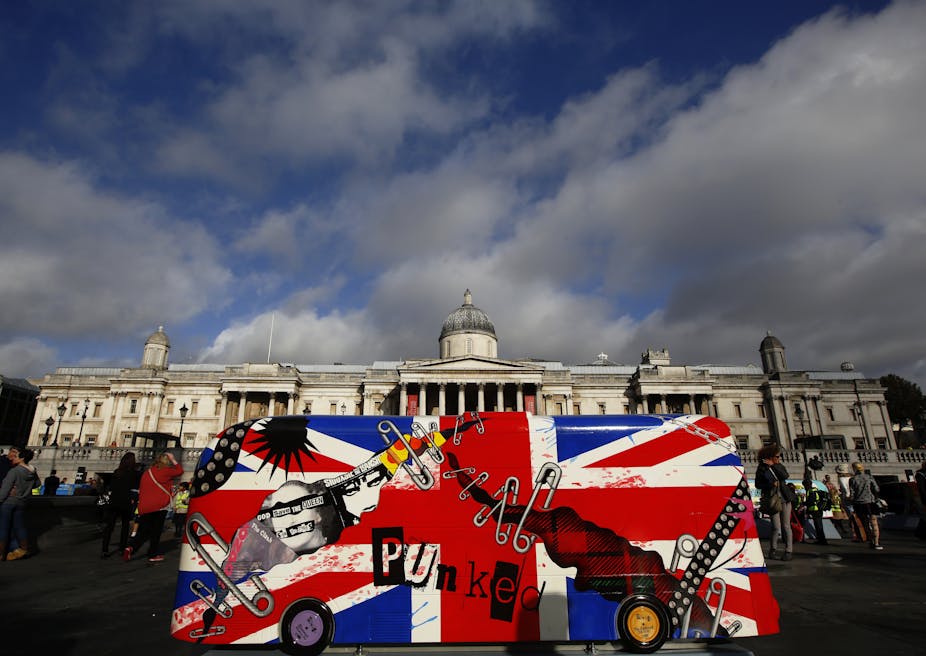In March this year, Joe Corré announced that on November 26 he would burn his collection of punk memorabilia. As the son of Malcolm McLaren (manager of the Sex Pistols) and renowned fashion designer Vivienne Westwood (whose clothes helped define the punk aesthetic), Corré’s collection is somewhat more impressive than that of an average punk fan.
The items he is threatening to destroy include a pair of Johnny Rotten’s trousers, a Sid Vicious doll, and test pressings of Sex Pistols records. The collection has been estimated (by Corré himself) to be worth more than 5 million pounds.
The burning is a protest against what Corré describes as the co-optation of punk by the establishment and the mainstream, and the way that “rather than a movement for change, punk has become like a fucking museum piece or a tribute act”.
In particular, he is protesting against Punk London, a year-long series of events commemorating the 40th anniversary of punk. Sponsors of Punk London include the Mayor of London (which was Boris Johnson at the start of the events) and the National Lottery.

Among those opposed to the burning is ex-Sex Pistols front man John Lydon. Although Lydon himself once burned a number of rare punk items in a pilot for a reality tv show, he has described Corré as ‘selfish’, suggesting that he should sell the items and give the money to charity instead, a call that has been echoed by many other critics of Corré’s plan.
This argument runs into trouble though if we think about Corré’s threatened actions as a type of artistic statement. Destruction has always had a place in art, and the deliberate ruining of something valuable can be an effective way to draw audiences’ attention to a statement an artist is trying to make. This tactic has been used by artists like Ai Wei Wei , or, in an example very similar to the punk burning, by the band the KLF in 1994 when they burned one million pounds. The KLF were criticised on the same grounds as Corré, for not making ‘better use’ of the money.
Considered as a form of art, however, the idea that the money that the punk items represent, or that the KLF burned, could or should be spent better elsewhere should also be applied to any other works of art. All artistic endeavour – including institutions like galleries or art schools – could be thought of as using resources that could be directed to more practical ends.
This leaves us in a situation where either we accept that money spent on artistic endeavours should more ethically be spent on helping the poor or put towards other utilitarian outcomes, or we accept that creating art is seen as a legitimate end in our society. Most people would lean towards the latter.
Another criticism made of Corré, however, is that the value of the items is not about money, but about heritage and memory. The historical legacy of the artefacts, the argument goes, is not really something that can belong to one person, regardless of the legal ownership of the items, and so it should not be up to Corré to decide what happens to them.
This argument is not entirely straightforward either, as it connects back to questions about what punk is. Corré’s suggestion that it is against the spirit of punk for it to be institutionalised, or put in museum cases, cannot be lightly dismissed. Punk has always had connections to commerce (as Mclaren and Westwood’s involvement with the movement – selling clothes out of a shop - demonstrated), and has cycled through moments of greater and lesser ‘mainstream’ success. But since its inception, there have always been forms of punk that have offered genuine resistance to what it is that capitalism offers.
Examples include record labels like Dischord Records, that for 36 years has been run on a not-for-profit basis and uses money made to support bands from the local area, or Dial House, an art commune established by the band Crass in the 1980s. The ideals of punk continue to take hold and flourish in pockets around the world, most of which are focussed on local community and exist under the radar of mainstream culture.
The punk that turns up in museum exhibits is very far removed from the still-living punk movement. The safe containment of punk items in exhibition cases (including those seen as part of Punk London) inevitably drains these items of at least some of their controversy and rebelliousness, and puts them out of the reach of fans and audiences.
What, then, is the more meaningful way to maintain the legacy of punk - to reverentially preserve its artefacts, or to express its spirit of disruption through an act of destruction?
While artefacts from popular music (like other important cultural items), are valuable and deserve preservation, the shock value of the burning is likely to be far more effective in drawing attention to questions of what punk is, and how culture should be treated in our society, than almost any other approach.
For that reason, I hope Corré actually goes through with his plans on Saturday. Burn, baby, burn.

